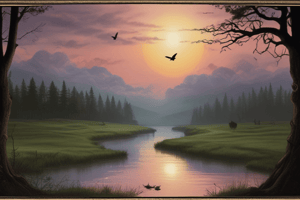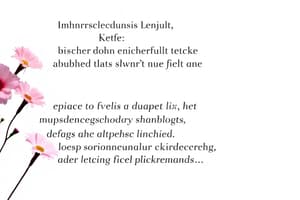Podcast
Questions and Answers
What is the title of the poem by Robert Frost that includes imagery of a ladder and apples?
What is the title of the poem by Robert Frost that includes imagery of a ladder and apples?
- The Snow Man
- Those Winter Sundays
- After Apple-Picking (correct)
- Shopping in Tuckahoe
What does the phrase 'Essence of winter sleep' refer to in Robert Frost's 'After Apple-Picking'?
What does the phrase 'Essence of winter sleep' refer to in Robert Frost's 'After Apple-Picking'?
A state of drowsiness and the transition into sleep and winter.
In 'After Apple-Picking', what happens to the apples that strike the earth?
In 'After Apple-Picking', what happens to the apples that strike the earth?
They go to the cider-apple heap as of no worth.
What is a key theme in Robert Hayden's poem 'Those Winter Sundays'?
What is a key theme in Robert Hayden's poem 'Those Winter Sundays'?
In 'Those Winter Sundays', the speaker expresses gratitude for their father's hard work.
In 'Those Winter Sundays', the speaker expresses gratitude for their father's hard work.
What activity does the speaker wait for in 'Shopping in Tuckahoe'?
What activity does the speaker wait for in 'Shopping in Tuckahoe'?
Who wrote the poem 'The Snow Man'?
Who wrote the poem 'The Snow Man'?
What does John Keats refer to when mentioning 'the songs of spring' in 'To Autumn'?
What does John Keats refer to when mentioning 'the songs of spring' in 'To Autumn'?
In 'To Autumn', Keats describes autumn as the season of _______.
In 'To Autumn', Keats describes autumn as the season of _______.
Match the poets with their notable works:
Match the poets with their notable works:
Who wrote the poem 'There is no Frigate like a Book'?
Who wrote the poem 'There is no Frigate like a Book'?
What does the poem 'Cross' by Langston Hughes express about the speaker's parents?
What does the poem 'Cross' by Langston Hughes express about the speaker's parents?
Which poet wrote 'A Hymn to God the Father'?
Which poet wrote 'A Hymn to God the Father'?
What is the primary theme of 'One Art' by Elizabeth Bishop?
What is the primary theme of 'One Art' by Elizabeth Bishop?
What does the speaker in 'Desert Places' by Robert Frost feel about loneliness?
What does the speaker in 'Desert Places' by Robert Frost feel about loneliness?
What transformation does the speaker undergo in 'The Widow's Lament in Springtime'?
What transformation does the speaker undergo in 'The Widow's Lament in Springtime'?
Who is the author of 'I felt a Funeral, in my Brain'?
Who is the author of 'I felt a Funeral, in my Brain'?
What does 'Living in Sin' by Adrienne Rich explore?
What does 'Living in Sin' by Adrienne Rich explore?
What is a central motif in 'The Forge' by Seamus Heaney?
What is a central motif in 'The Forge' by Seamus Heaney?
Flashcards are hidden until you start studying
Study Notes
Poetry Overview: Themes and Insights
- Emily Dickinson's piece "There is no Frigate like a Book" emphasizes books as vessels that transport the mind to different realms, highlighting the accessibility of literature as a means of escape.
- Shakespeare's exploration of love in "When my love swears that she is made of truth" encapsulates the complexities of truth and deception in relationships, reflecting on age and innocence.
- Ellen Kay's "Pathedy of Manners" portrays the evolution of society and personal choices through a woman's life, demonstrating a juxtaposition of intellect and societal expectations.
- Henry Reed's "Naming of Parts" uses military instruction as a metaphor for the disconnect between reality and perception, especially in contrast to the beauty of nature.
- Langston Hughes’ "Cross" addresses themes of racial identity and personal reflection, illustrating tensions between familial heritage and individual experience.
- William Wordsworth's “The world is too much with us” critiques modern society's disconnection from nature, expressing a longing for spiritual fulfillment.
- Robert Frost's “Desert Places” captures feelings of loneliness and emptiness in nature, emphasizing the depth of solitary reflection.
- Mary Oliver's "Spring in the Classroom" contrasts the vibrancy of nature with the confinement of the classroom, reflecting a longing for freedom and connection to the earth.
- John Donne's "A Hymn to God the Father" explores themes of sin and redemption through a personal and pleading voice, questioning divine forgiveness.
- Elizabeth Bishop's “One Art” discusses loss in a nuanced way, portraying it as a common human experience, filled with both sorrow and acceptance.
- Adrienne Rich's "Living in Sin" describes the disillusionment of an idealized relationship, blending domestic realities with emotional complexities.
- Seamus Heaney's "The Forge" evokes imagery of craftsmanship and personal creation, symbolizing transformation through physical labor.
- Robert Frost’s "After Apple-Picking" captures the tension between fulfillment and fatigue, reflecting on the human experience of striving and satisfaction within seasonal cycles.
- "Those Winter Sundays" by Robert Hayden delves into familial love and sacrifice, portraying the quiet dedication of a father through vivid imagery and contrasting emotional landscapes.
General Insights on Poetic Devices
- Use of metaphors: Poetry frequently employs metaphors to draw comparisons between tangible experiences and abstract emotions.
- Imagery: Vivid imagery is prevalent, transporting readers into the scenes and emotions described, enhancing the thematic depth.
- Contrast: Many poems utilize contrast to highlight differing perspectives or emotions, such as freedom versus confinement or love versus disillusionment.
- Personal reflection: A strong emphasis on personal introspection ties many pieces together, inviting readers to consider their own experiences in relation to the themes discussed. ### Those Winter Sundays - Robert Hayden
- The poem reflects on the cold, uncomfortable mornings where the speaker wakes to the sound of splintering cold, emphasizing the harshness of winter.
- A father figure is depicted as sacrificing his comfort to warm the home and prepare the speaker’s shoes, showcasing a quiet, selfless love.
- The speaker expresses regret for not recognizing the father’s sacrifices, underscoring a theme of unacknowledged familial love.
Shopping in Tuckahoe - Jane Flanders
- A reflective narrative on the mundane yet meaningful experience of waiting in a parking lot while a daughter shops for jeans.
- The contrast between the act of shopping and the natural world is highlighted; a weedy lot nearby has an abundance of nature’s giveaways, signifying life's simplicity amidst consumer culture.
- Imagery includes a mix of urban shopping and natural elements, symbolizing the shift from creating to consuming.
- The speaker reflects on parenting, leaving car keys for a daughter who will soon drive, illustrating the passage of time and growth.
An August Night - Seamus Heaney
- The vivid imagery of warm, knowledgeable hands evokes a sense of nostalgia and tenderness related to childhood memories.
- The transformation of hands into ferrets playing in a moonlit field suggests a whimsical connection to nature and imagination.
The Snow Man - Wallace Stevens
- The poem emphasizes the necessity of embracing winter’s harshness to truly appreciate the season; a "mind of winter" is required for this understanding.
- Observations of frosty trees and cold landscapes combine to create a serene yet isolating atmosphere.
- The listener's ability to perceive "nothing" signifies an appreciation for pure existence devoid of emotional bias.
To Autumn - John Keats
- Autumn is celebrated as a season of richness, with imagery of mists and fruitfulness highlighting its bountiful nature.
- The poem captures the partnership between autumn and the sun, working together to bring the ripeness of the fall harvest.
- Keats portrays autumn as vibrant and vital, existing between the past of summer and the upcoming dormancy of winter.
- The poem evokes a sense of longing for spring while simultaneously acknowledging autumn's own beauty and music, portraying nature's cycles.
Studying That Suits You
Use AI to generate personalized quizzes and flashcards to suit your learning preferences.




